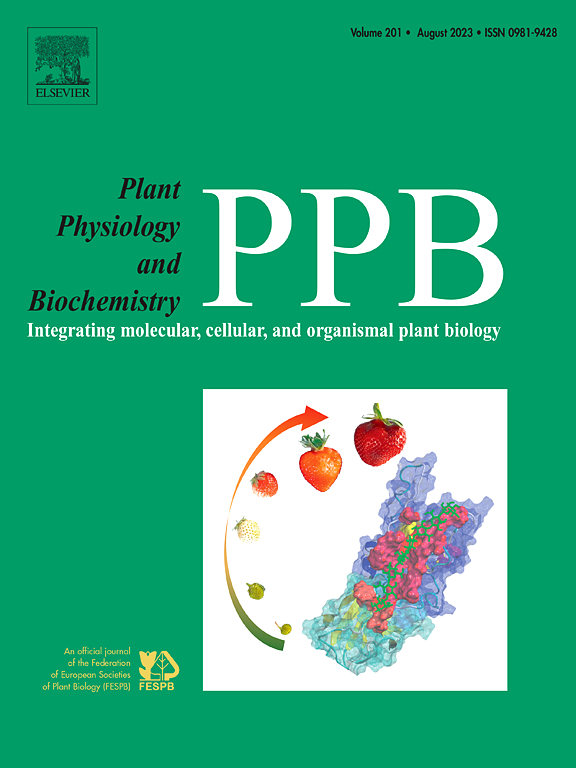Growth, photosynthesis, redox homeostasis, secondary metabolism and metabolomic changes of Pinellia ternata under antibiotic stress: A comparative study of oxytetracycline, norfloxacin and sulfamethazine
IF 6.1
2区 生物学
Q1 PLANT SCIENCES
引用次数: 0
Abstract
Antibiotics, as emerging pollutants with high residual levels in the soil, can affect plant growth. However, the influence of multiple antibiotics on the secondary metabolism in medicinal plants remains understudied. The antitumor, antibacterial, and anti-inflammatory pharmacological effects of Pinellia ternata are attributed to the secondary metabolites in its tubers. The purpose of this study was to investigate the impact of oxytetracycline (OTC), norfloxacin (NF), and sulfamethazine (SMZ) (100 mg kg−1 w/w) on growth, photosynthesis, active oxygen metabolism, ascorbate-glutathione (AsA-GSH) cycle, secondary metabolism, and untargeted metabolomics of P. ternata. The findings indicated that three antibiotic treatments inhibited P. ternata growth by reducing the chlorophyll contents, Fv/Fm and Y(NPQ) values, and stimulating the reactive oxygen species (ROS) metabolism, with SMZ treatment having the strongest inhibitory effect. OTC treatment significantly increased the flavonoid and β-sitosterol contents, while NF and SMZ treatments reduced secondary metabolite contents. Metabolomics results showed that carotenoid biosynthesis and glycerophospholipid metabolism were the most significant pathways enriched in OTC and NF treatments, respectively. SMZ treatment regulated more metabolic pathways than OTC and NF treatments, primarily involving amino acid metabolism. The above results indicated that OTC treatment promoted the secondary metabolism of P. ternata although it inhibited growth. NF and SMZ treatments inhibited the growth and secondary metabolism of P. ternata. The significance lies in elucidating the effects and regulatory mechanisms of different antibiotics on medicinal plants, and providing a theoretical foundation for the quality and safety of secondary metabolites in medicinal plants affected by antibiotic exposure.

抗生素胁迫下半夏的生长、光合、氧化还原稳态、次生代谢及代谢组学变化:土霉素、诺氟沙星和磺胺嘧啶的比较研究
抗生素作为土壤中残留水平较高的新兴污染物,会影响植物的生长。然而,多种抗生素对药用植物次生代谢的影响尚不清楚。半夏的抗肿瘤、抗菌和抗炎药理作用归因于其块茎中的次生代谢物。本研究的目的是研究土霉素(OTC)、诺氟沙星(NF)和磺胺乙嗪(SMZ) (100 mg kg−1 w/w)对P. ternata生长、光合作用、活性氧代谢、抗坏血酸-谷胱甘肽(AsA-GSH)循环、次生代谢和非靶向代谢组学的影响。结果表明,3种抗生素处理均通过降低叶绿素含量、Fv/Fm和Y(NPQ)值以及刺激活性氧(ROS)代谢来抑制P. ternata的生长,其中SMZ处理的抑制作用最强。OTC处理显著提高了黄酮类化合物和β-谷甾醇含量,NF和SMZ处理显著降低了次生代谢物含量。代谢组学结果显示,类胡萝卜素生物合成和甘油磷脂代谢分别是OTC和NF处理中最显著的富集途径。与OTC和NF处理相比,SMZ处理调节了更多的代谢途径,主要涉及氨基酸代谢。上述结果表明,OTC虽然抑制了柽柳的生长,但促进了柽柳的次生代谢。NF和SMZ处理均抑制了柽柳的生长和次生代谢。其意义在于阐明不同抗生素对药用植物的作用和调控机制,为抗生素暴露对药用植物次生代谢产物的质量和安全提供理论依据。
本文章由计算机程序翻译,如有差异,请以英文原文为准。
求助全文
约1分钟内获得全文
求助全文
来源期刊
CiteScore
11.10
自引率
3.10%
发文量
410
审稿时长
33 days
期刊介绍:
Plant Physiology and Biochemistry publishes original theoretical, experimental and technical contributions in the various fields of plant physiology (biochemistry, physiology, structure, genetics, plant-microbe interactions, etc.) at diverse levels of integration (molecular, subcellular, cellular, organ, whole plant, environmental). Opinions expressed in the journal are the sole responsibility of the authors and publication does not imply the editors'' agreement.
Manuscripts describing molecular-genetic and/or gene expression data that are not integrated with biochemical analysis and/or actual measurements of plant physiological processes are not suitable for PPB. Also "Omics" studies (transcriptomics, proteomics, metabolomics, etc.) reporting descriptive analysis without an element of functional validation assays, will not be considered. Similarly, applied agronomic or phytochemical studies that generate no new, fundamental insights in plant physiological and/or biochemical processes are not suitable for publication in PPB.
Plant Physiology and Biochemistry publishes several types of articles: Reviews, Papers and Short Papers. Articles for Reviews are either invited by the editor or proposed by the authors for the editor''s prior agreement. Reviews should not exceed 40 typewritten pages and Short Papers no more than approximately 8 typewritten pages. The fundamental character of Plant Physiology and Biochemistry remains that of a journal for original results.

 求助内容:
求助内容: 应助结果提醒方式:
应助结果提醒方式:


